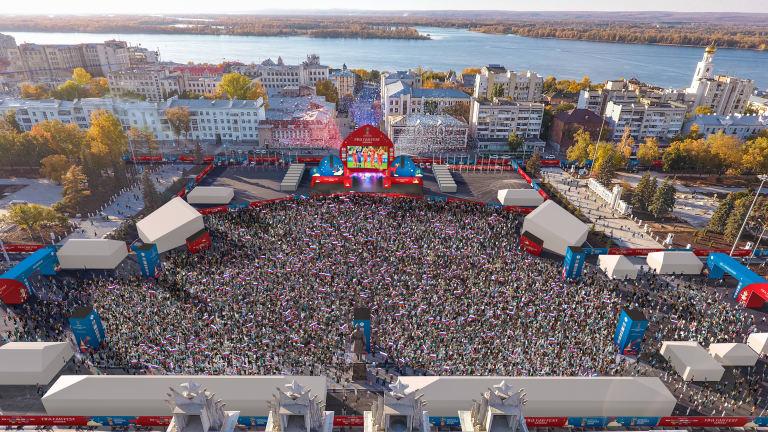World Cup 2018: What to do in Samara besides the football
The venue for Saturday's England v Sweden quarter-final celebrates outer space and plumbs the depths of Stalin's bunker

Your support helps us to tell the story
From reproductive rights to climate change to Big Tech, The Independent is on the ground when the story is developing. Whether it's investigating the financials of Elon Musk's pro-Trump PAC or producing our latest documentary, 'The A Word', which shines a light on the American women fighting for reproductive rights, we know how important it is to parse out the facts from the messaging.
At such a critical moment in US history, we need reporters on the ground. Your donation allows us to keep sending journalists to speak to both sides of the story.
The Independent is trusted by Americans across the entire political spectrum. And unlike many other quality news outlets, we choose not to lock Americans out of our reporting and analysis with paywalls. We believe quality journalism should be available to everyone, paid for by those who can afford it.
Your support makes all the difference.The venue for Saturday’s World Cup quarter final between England and Sweden is Russia’s sixth-largest city. It is on the same latitude as Liverpool, and almost as far east as Qatar – where the 2022 World Cup is due to be staged.
As with the venues for England’s first two matches (Volgograd and Nizhny Novgorod, both wins), Samara is on the Volga river. The city grew up at the confluence of the Volga and Samara rivers and is fringed by the impressive Zhiguli mountains, which give their name to Samara’s brewery.
For a millennium, the city’s strategic location has made it relatively prosperous (the city’s patron saint, Alexius, is said to have predicted it would never be conquered).
As with Nizhny Novgorod, during the Soviet era Samara had a different name and was closed to visitors.
In 1935 the Bolshevik leader, Valerian Kuybyshev, drank himself to death, and the city was promptly named after him. It reverted to its original name in 1991, but Samara’s main square – claimed to be the largest in Europe – is still named Kuybyshev.
Getting there
The city used to have its own carrier, Samara Airlines, but it went bust a decade ago. The key international link is on Turkish Airlines via Istanbul, with connections from Gatwick, Heathrow, Birmingham and Manchester. Fares going out on Thursday, back on Sunday, are currently around £1,000 return. Another option is Czech Airlines from Prague. Alternatively, go via Moscow (on Aeroflot or British Airways’ partner, S7 Airlines).
Samara’s Kurumoch airport is 35km (22 miles) north of the city. Trains direct from the airport to Samara take one hour and 16 minutes, for a fare of under £2.
The fastest train from Moscow takes 13 hours.
Getting around
Walking is the easiest mode of transport in Samara’s relatively small city centre. Buses and trams are cheap, and free to holders of a Fan-ID. The city has a Metro underground railway, but it has just eight stops and is of little use to tourists.
Check in
Grab a room at the Bristol Zhiguli hotel, “located simultaneously in the historic and business centre of the city”. If that doesn’t suit, try the Ibis or Holiday Inn.
Seeing the sights
During the Second World War, Samara/Kuybyshev was designated as the auxiliary Soviet capital if Moscow fell to Nazi Germany. The city’s top tourist attraction dates from that era: Stalin’s Bunker was dug for him in 1942 as the Eastern Front approached Moscow.
Two thousands convicts were deployed to create it 120 feet below ground, beneath the Academy of Culture and Art.
The Soviet space effort is celebrated in the Samara Municipal Museum of the Cosmos, though many visitors make do with the large rocket outside.
The embankment beside the Volga is a lovely place to walk or cycle, and the Zhiguli Brewery is also on the riverside.
Eating and drinking
Head to the Staraya Kvartira, which translates as Old Apartment, where you go through a souvenir shop into what feels like someone’s Soviet-era flat. Dishes include typical Russian fare including salted fish and sour cream with pickles.
Back in the USSR, the best cuisine was Georgian, and that is celebrated at the Cafe Puri. Other restaurants to check out include Kipyatok for breakfast or afternoon tea, Kon V Palto and U Palycha.
The city is simultaneously Russia’s beer capital and the subject of the nation’s drinking song, which goes: “Oh, Samara the little town, I am so restless – give me some rest.”
If you don't fancy Zhiguli's, Harat’s Irish pub sells Guinness stout, Harp lager and London Pride ale.
The football
Construction began on the Samara Arena less than four years ago, and was finished close to the wire. The stadium in the Radiotsentar district resembles a cross between a flying saucer and an airport terminal, only holding rather more people: 45,000. The design is said to be inspired by space.
After the quarter-final, the local club FC Krylya Sovetov will take over - leaving behind their current stadium, with the marvellous name of Metallurg.
Join our commenting forum
Join thought-provoking conversations, follow other Independent readers and see their replies
0Comments